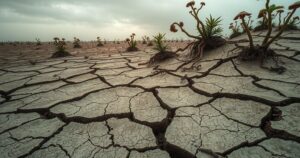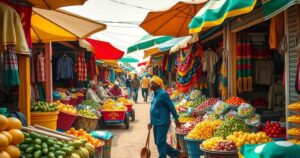Comoros Economic Update: An Ocean of Opportunities – Blue Economy as a Driver of Sustainable Growth

Comoros’ economy is recovering with a projected growth of 3.4% in 2024, yet it continues to face issues of poverty and inequality. The blue economy offers transformative potential through fishing, tourism, and conservation efforts. Essential reforms are needed to enhance fiscal sustainability and governance. The inaugural Comoros Economic Update underscores how the blue economy can drive growth while ensuring ecological protection.
Comoros is experiencing a gradual economic recovery with projections showing growth rising to 3.4% in 2024. However, this growth rate is still insufficient to address ongoing issues of poverty and inequality within the nation. Despite an optimistic medium-term outlook, Comoros is grappling with several macroeconomic risks, such as reliance on imports, a lack of export diversification, and exposure to both climate and external shocks.
As Comoros aims for sustained economic growth, it will need to enhance fiscal sustainability, improve governance, and bolster private sector competitiveness. One shining opportunity lies in tapping into the blue economy, which encompasses expanding fisheries, marine tourism, and conservation initiatives. By focusing on infrastructure development and environmental safeguards, Comoros stands to realize significant potential through its maritime resources.
The inaugural Comoros Economic Update report, titled “An Ocean of Opportunities: Blue Economy as a Driver of Sustainable Growth,” sheds light on recent economic trends alongside a medium-term outlook. The report emphasizes how the blue economy can generate growth, create employment opportunities, and protect ecosystems while ensuring resources remain sustainable for the long run.
While the economy is on a slow ascent, the situation remains dire for many citizens. The modest growth from 3% to 3.4% in 2024 is largely fueled by household consumption and services, underpinned by increased remittances and a pullback in inflation. However, despite growth in agriculture and industry, per capita income remains stagnant and poverty levels persist. Moreover, public finances are strained; with government revenues stable at 16.6% of GDP, expenditures have risen due to large externally funded projects, creating a widening fiscal deficit from 1.3% to 3.9%. Public debt has surged to 36.8% of GDP, leading organizations like the IMF and World Bank to label Comoros at high risk of debt distress.
Remittances, which have averaged 11.3% of GDP over the past decade, constitute a crucial part of household income but cannot sufficiently counterbalance trade deficits or finance developmental projects. Additionally, challenges in the banking sector, including elevated levels of non-performing loans and solvency issues, hinder credit access and overall private sector growth. Addressing public finances, diversifying the economy, and implementing inclusive reforms are vital to achieve sustainable economic growth in the long term.
Looking ahead, between 2025 and 2027, Comoros is set to maintain steady growth, primarily driven by private consumption and public investment in infrastructure, especially in light of the upcoming 2027 Indian Ocean Island Games. Inflation is projected to taper off, supported by reforms like liberalizing rice imports. Still, there are serious macroeconomic challenges—high import reliance, narrow export diversification, and continuous inflationary pressures weigh heavily on the country. The potential accession to the WTO might create new markets but could result in decreased trade revenues without strategic policies to support this transition.
The looming threats from climate change, natural disasters, and global economic fluctuations pose significant risks to stability. In addition, ineffective governance, youth unemployment, and a shortage of formal job opportunities impede Comoros’s ability to respond to these mounting challenges. The reform of fiscal policy, incentivizing private sector growth, and strengthening governance will be essential in building resilience against future shocks.
With public debt anticipated to reach 37% of GDP in 2024 and domestic revenue generation lagging behind global standards, fiscal space remains constrained. Reforms aimed at expanding the tax base, enhancing tax administration and public financial management are paramount. The pursuit of stronger debt transparency and reliance on concessional financing is crucial to mitigate financial distress. The private sector needs support by easing regulations, improving access to finance, and leveraging remittances.
Accession to the WTO presents opportunities for diversifying exports, particularly in the fisheries and agriculture sectors. However, substantial investments in trade logistics and quality infrastructure are necessary for realizing these prospects. Moreover, comprehensive financial sector reforms must address challenges like high non-performing loans and promote financial inclusion. Enhancing governance frameworks, improving oversight of state-owned enterprises, and vigorously combatting corruption will foster better service delivery and inspire investor confidence.
In terms of the blue economy, Comoros has vast, underutilized potential primarily in fisheries and marine tourism, though translating this advantage into actual economic development has proven complex. Ineffective infrastructure, outdated practices, and poor market access limit growth in the fisheries sector. By effectively implementing a blue economy strategy that prioritizes governance reforms, infrastructure investment, and environmental stewardship, Comoros can boost GDP and work towards achieving upper-middle-income status by 2050. These objectives align closely with the aspirations of the Plan Emergent Comores 2030, which emphasizes sustainable resource management and climate resilience. To succeed, key priorities will include modernizing the fisheries sector, enhancing aquaculture, upgrading port and energy infrastructure, and improving financial inclusion for women and micro, small, and medium enterprises (MSMEs). Through strong governance, marine spatial planning, and a focus on digital innovation, Comoros can sustainably manage its resources. It is crucial to synchronize human capital development, climate resilience, and inclusive finance in order to unlock the full potential of the blue economy and foster long-term, inclusive, and sustainable growth.
The economic outlook for Comoros presents both challenges and opportunities. While growth is occurring, persistent poverty and inequality remain significant issues. The blue economy holds substantial promise for driving sustainable development, provided that necessary reforms and investments are implemented. It is essential for Comoros to strengthen governance, fiscal policies, and private sector competitiveness to ensure economic resilience and prosperity moving forward.
Original Source: www.worldbank.org








